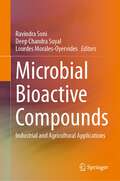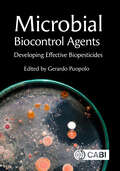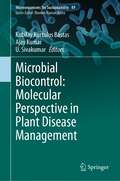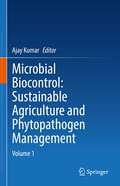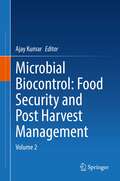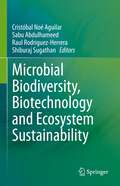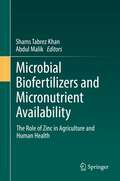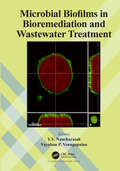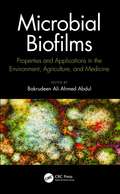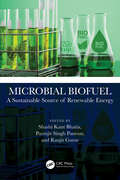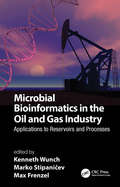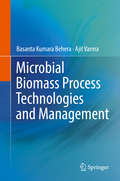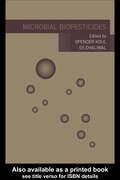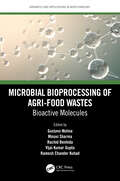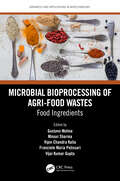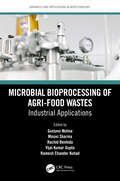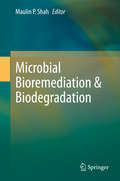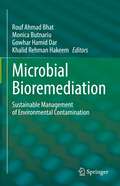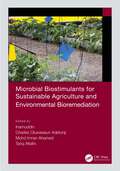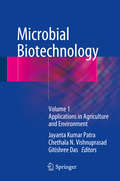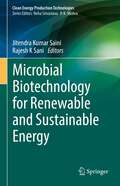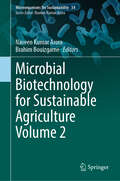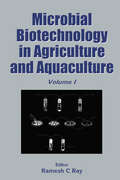- Table View
- List View
Microbial Bioactive Compounds: Industrial and Agricultural Applications
by Ravindra Soni Deep Chandra Suyal Lourdes Morales-OyervidesThis book delves into microbial production and its implications for various industries and presents the latest advancements in the field of bioactive compound production by microorganisms. Divided into 16 chapters, the book covers a wide range of topics, starting with the emerging trends in microbial production techniques, followed by the potential of fungi and algae in producing bioactive compounds, and the applications of bioactive compounds in medicine, agriculture, and industry. Contributions from expert scientists emphasize the significance of metabolic engineering and modern analytical techniques for the extraction, purification, and structural characterization of microbial bioactive compounds. The authors also present alternative technologies and methodologies for the recovery and extraction of these compounds from microbial sources and highlight the health-promoting benefits of natural plant-derived bioactive compounds. Particular attention is given to nanocarriers and their potential for managing the delivery of bioactive compounds in therapeutic applications. The importance of actinomycetes and their bioactive potential in the agricultural sector is also discussed. In this book, readers will also find out about the importance of microbial community dynamics in Antarctica, their ecological potential, and their industrial application. The last chapter of the book offers an industrial perspective of microbial pigments and their applications. This book is a valuable resource for researchers, academics, and industry professionals seeking to understand and harness the potential of microbial bioactive compounds for sustainable development, industrial applications, and improved human well-being.
Microbial Biocontrol Agents: Developing Effective Biopesticides
by Vittorio Rossi Bernard R. Glick Laure Weisskopf Antonieta De Cal Paloma Melgarejo Marc Bardin Abhishek Anand Ana Bejarano Elisa Bona Tito Caffi Hamza Chammem Margherita Furiosi Elisa Gamalero Belén Guijarro Lars Huber Dr Ajay Kumar Inmaculada Larena Sara E. Legler Carla S. Lorenz Hassan Momeni Fahimeh Nazari Andrea Nesler Philippe Nicot Ma. del Orozco-Mosquedab Ilaria Pertot Thomas Pressecq Dr Gerardo Puopolo Naser Safaie Gustavo Santoyo Selena Tomada Estelle Turc Maria Villarino Mout De VriezeThe negative impact of chemical pesticides on human wellbeing and the environment has encouraged the development of eco-friendly alternatives for the management of plant pathogens. However, only a small number of microbial biocontrol agents (mBCAs) have been developed, registered and used in the management of plant diseases. This book analyses the deployment of mBCAs for the development of novel microbial biopesticides, considering the main plant-beneficial traits, procedures needed for effective formulations and the processes used for their validation. To guide the readers through the world of microbial biopesticides, the book starts with a chapter dedicated to the regulations that need to be followed for the development of final products. Readers will understand the importance of formulation and mode of action of mBCAs in developing microbial biopesticides. They will become familiar with key mBCAs such as Ampelomyces quisqualis, Bacillus spp., Trichoderma spp., and Pseudomonas spp., understanding the importance of formulation for their application in the field. This book explains the use of mBCAs to control post-harvest diseases and the potential of endophytic microorganisms as next-generation microbial biopesticides. A final chapter provides a useful workflow for the selection of new mBCAs and describes microbial species including promising mBCAs that might be developed as new microbial biopesticides. - Gives useful insights into the practicalities of regulation of mBCAs - Describes the underlying biology that it is critical to developing mBCAs - Provides case studies for key mBCA species - Indicates microbial species exploitable for the development of new microbial biopesticides For students and researchers involved in crop protection and biological control
Microbial Biocontrol: Molecular Perspective in Plant Disease Management (Microorganisms for Sustainability #49)
by Ajay Kumar Kubilay Kurtulus Bastas U. SivakumarThis book is exploring molecular insight of plant disease resistance, enhancing plant immunity as well as the latest omics or approaches in plant disease management. In the recent past, microbial strains or products frequently utilized to inhibit the growth of phytopathogen and disease management. However, it is well known that plants respond to numerous biotic and abiotic stresses by morphological, biochemical, and molecular mechanisms. But still there is much more to study about their molecular aspect of interaction between host- pathogens- biocontrol agents that will be helpful in formulation and applications of microbial antagonistic for effective management of phytopathogens. This book attempt to fill this gap in the literature. This book is of interest to teachers, researchers, agronomist, horticulturalist scientists, capacity builders and policymakers. Also the book serves as additional reading material for undergraduate and graduate students of agriculture, microbiology, environment science.
Microbial Biocontrol: Volume 1
by Ajay KumarThis first volume of a two-volume work presents the manifold applications of beneficial microbes and microbiomes in plant growth promotion, in enhancing crop resilience and in control of phytopathogens through microbial antagonists. In-depth insights into latest technologies such as biopriming of seeds and soil inoculation of rhizosphere microorganisms are provided.The two-volume work “Microbial Biocontrol” introduces mechanisms of plant-microbe interactions and explores latest strategies of how microbes can be applied in biocontrol and management of plant pathogens, replacing chemical fertilizers and pesticides. The book covers different groups of microorganisms such as bacteria, fungi, but also the interplay of entire microbiomes, and reviews their specific benefits in crop growth promotion, in enhancing the plants’ tolerance against biotic and abiotic stress as well as in post-harvest management of various plant diseases. Novel tools such as CRISPR/Cas9 and microbe derived nanoparticles are also addressed besides the legal aspects of biocontrol applications.Today, rising global population and changing climatic conditions emerge as a major challenge for agronomist farmers and researchers in fulfilling the requirements of global food production. The conventional agricultural practices utilize undistributed use of chemical fertilizers and pesticides to enhance growth and yield of agricultural products and fresh foods, but their extensive and continuous use have led to a range of negative consequences on the food quality and safety, to environment as well as to human and animal health. Microbial biocontrol applications are presented as a solution, paving the way to a sustainable agriculture in compliance with the UN Sustainable Development Goals (SDG). The book addresses researchers in academia and agriculture.
Microbial Biocontrol: Volume 2
by Ajay KumarThis second volume of a two-volume work reviews beneficial bioactive compounds from various microorganisms such as bacteria, fungi, cyanobacteria in plant diseases management and the postharvest management of fruits using microbial antagonists. Furthermore, it reviews the impact of climate change on food security and addressed the legal aspects of microbial biocontrol applications. The two-volume work “Microbial Biocontrol” introduces to mechanisms of plant-microbe interactions and explores latest strategies of how microbes can be applied in biocontrol and management of plant pathogens, replacing chemical fertilizers and pesticides. The book covers different groups of microorganisms such as bacteria, fungi, but also the interplay of entire microbiomes, and reviews their specific benefits in crop growth promotion, in enhancing the plants’ tolerance against biotic and abiotic stress as well as in post-harvest management of various plant diseases. Novel tools such as CRISPR/Cas9 and microbe derived nanoparticles are also addressed besides the legal aspects of biocontrol applications. Today, rising global population and changing climatic conditions emerge as a major challenge for agronomist farmers and researchers in fulfilling the requirements of global food production. The conventional agricultural practices utilize undistributed use of chemical fertilizers and pesticides to enhance growth and yield of agricultural products and fresh foods, but their extensive and continuous use have led to a range of negative consequences on the food quality and safety, to environment as well as to human and animal health. Microbial biocontrol applications are presented as a solution, paving the way to a sustainable agriculture in compliance with the UN Sustainable Development Goals (SDG). The book addresses researchers in academia and agriculture.
Microbial Biodiversity, Biotechnology and Ecosystem Sustainability
by Sabu Abdulhameed Shiburaj Sugathan Cristóbal Noé Aguilar Raul Rodriguez-HerreraThis book gives insight into several aspects of the microbiology, biotechnology, and ecosystem sustainability of special and under-explored regions, that captivate human beings by their natural richness, their extensive biodiversity, the extraordinary forms of adaptation of the living beings that they inhabit, and even that keep living secrets as is the very origin of life. The chapters emphasize all aspects of biological diversity-its description, analysis, and conservation, and its controlled rational use by humankind. Also, the book is elaborated from a wide and multidisciplinary point of view. It presents reviews, research papers, comments, and research notes on biodiversity, ethnobiology, geoscience, chemistry, biological conservation, biotechnology, and ecosystem sustainability Two hotspots are the reference for this enriching book that describes details of extraordinary areas of the planet, from Cuatrociénegas, Coahuila (Mexico) to the Southern Western Ghats (India). The book will contribute to dealing with the practicalities of conservation management, economic, social, and political issues. It provides a forum for examining conflicts between sustainable development and human dependence on biodiversity in agriculture, environmental management, and biotechnology, and encourages contributions from developing countries to promote broad global perspectives on matters of biodiversity and conservation.
Microbial Biofertilizers and Micronutrient Availability: The Role of Zinc in Agriculture and Human Health
by Abdul Malik Shams Tabrez KhanThis volume addresses various issues related to micronutrient deficiency, especially zinc, and discusses the possible approaches for combating mineral deficiency among humans and plants. The book mainly focuses on the zinc biofortification of vegetable and cereal crops and highlights the consequences of zinc deficiency and the health risks associated with zinc deficiency, especially in children and expecting mothers. The authors discuss different types of food that are rich in zinc and other minerals, how diets can be designed to meet the daily zinc requirements, and the impact of zinc deficiency on plant health and quality of agricultural products and the role of micronutrients in abiotic stress tolerance. The book also covers sustainable approaches to zinc biofortification in crops, such as the microbial solubilization of zinc in soil to improve zinc uptake by plants, and the formulation of these microbes into biofertilizers. The book will be of interest to dieticians, agricultural scientists, students and microbiologists.
Microbial Biofilms in Bioremediation and Wastewater Treatment
by Vayalam P. Venugopalan Y. V. NancharaiahBiofilms represent the natural living style of microbial communities and play a pivotal role in biogeochemical cycles and natural attenuation. Biofilms can be engineered for biodegradation and biotransformation of organic and inorganic contaminants, for both in situ bioremediation and ex situ treatment in bioreactors. This book focuses on microbial biofilms and their potential technological applications for sustainable development. It covers recent advances in biofilm technologies for contaminant remediation coupled to recovery of resources and serves as a complete reference on the science and technology behind biofilm mediated bioremediation and wastewater treatment.
Microbial Biofilms: Properties and Applications in the Environment, Agriculture, and Medicine
by Bakrudeen Ali Ahmed AbdulThis book provides a broad range of applications and recent advances in the search for biofilm materials in nature. It also explains the future implications for biofilms in the areas of advanced molecular genetics, pharmaceuticals, pharmacology, and toxicology. This book is comprised of 20 chapters from leading experts in the field and it examines immunology and microbiological studies derived from biofilms as well as explores environmental, agricultural, and chemical impacts on biofilms. It is divided into five subdivisions: biofilms and its complications, biofilm infections in human body, detection of biofilm-forming pathogens, antibiofilm chemotherapy, and biofilms production tools in aquaculture. This book may be used as a text or reference for everyone interested in microbial biofilms and their current applications. It is also highly recommended for environmental microbiologists, medical microbiologists, bioremediation experts, and microbiologists working in biocorrosion, biofouling, biodegradation, water microbiology, quorum sensing, and many other related areas. Scientists in academia, research laboratories, and industry will also find it of interest. This book includes chapter homework problems and case studies. Powerpoints are also available for adopting instructors. Discusses and clarifies the resource of isolation and chemical properties from biofilms Discusses the latest pharmaceutical, pharmacological, and medicinal approaches toward the treatment of chronic and uncured diseases, such as Alzheimer’s osteoporotic, sexual dysfunction, sleep sickness, allergy treatment, asthma, hair loss, AIDS, hypertension, antiaging, etc. Examines immunology and microbiological studies derived from biofilms Explores environmental, agricultural, and chemical impacts on biofilms. Dr. Bakrudeen Ali Ahmed Abdul is an Associate Professor, the Head of the Department of Biochemistry and Dean of the School of Life Sciences, Centre for Research and Development (CRD), PRIST Deemed University, Vallam, Thanjavur, Tamil Nadu, India. His research areas include the application of plant biochemistry, bioactive compound production, biotechnological methods, development of pharmaceutical products and pharmacological studies.
Microbial Biofuel: A Sustainable Source of Renewable Energy
by Shashi Kant Bhatia Parmjit Singh Panesar Ranjit GuravMicrobial Biofuel: A Sustainable Source of Renewable Energy explores microbial biofuel production from a technical standpoint addressing a wide range of topics including bio alcohol, biodiesel, biohydrogen, biomethane, biohythane, jet fuel, drop-in fuel, bioelectricity, bio-oil, biomass to biofuel, carbon capture, and more.Each chapter provides an in-depth examination of a specific biofuel type, discussing the underlying science, production processes, challenges, and its potential applications. The title draws examples from the latest research and advancements in the field, including cutting-edge technologies, methodologies, and case studies. It covers advances in fermentation strategies and commercial-scale implementation of microbial technology for biofuel production along with comprehensive information on bio alcohol, biodiesel, biohydrogen, biomethane, etc. The book explores practical applications of microbial biofuels and uses real-life examples and case studies. Moreover, the book discusses sustainability and environmental benefits of using renewable energy.The title is an ideal read for graduate students and researchers specialising in bioenergy and chemical engineering.
Microbial Bioinformatics in the Oil and Gas Industry: Applications to Reservoirs and Processes (Microbes, Materials, and the Engineered Environment)
by Kenneth Wunch Max Frenzel Marko StipanicevThis book brings together contributions from leading scientists, academics, and experts from the oil and gas industry to discuss microbial-related problems faced by the industry and how bioinformatics and an interdisciplinary scientific approach can address these challenges. Microbial Bioinformatics in the Oil and Gas Industry: Applications to Reservoirs and Processes presents the major industrial problems caused by microbes (e.g., souring, biocorrosion) as well as the beneficial activities (e.g., biofuels, bioremediation). FEATURES Offers a detailed description of how bioinformatics has advanced our understanding of numerous issues in the oil and gas industry Covers cases from geographically diverse oil fields, laboratories, and research groups Contains fundamentals and applied information of relevance to the oil and gas sector Presents contributions from a team of international experts across industry and academia With its cross-disciplinary approach, this comprehensive book provides microbial ecologists, molecular biologists, operators, engineers, chemists, and academics involved in the sector with an improved understanding of the significance of microbial bioinformatics applications in the oil and gas industry.
Microbial Biomass Process Technologies and Management
by Ajit Varma Basanta Kumara BeheraThis book describes how microbes can be used as effective and sustainable resources to meet the current challenge of finding suitable and economical solutions for biopharmaceuticals, enzymes, food additives, nutraceuticals, value added biochemicals and microbial fuels, and discusses various aspects of microbial regulatory activity and its applications. It particularly focuses on the design, layout and other relevant issues in industrial microbe applications. Moreover, it discusses the entire microbial-product supply chain, from manufacturing sites to end users, both in domestic and international markets, providing insights into the global marketing of microbes and microbial biomass-derived products. Further, it includes topics concerning the effective production and utilization of eco-friendly biotechnology industries. It offers a valuable, ready-to-use guide for technologists and policymakers developing new biotechnologies.
Microbial Biopesticides
by Opender Koul G. S. DhaliwalBiotechnological research has provided key developments in pest control agents, focusing on pathogens of insect pests as formulated biological pesticides. Emphasis has been placed on bacteria and viruses as they are well understood and easily manipulated. Microbial Biopesticides provides a comprehensive overview of the advances made in the use of bacteria, fungi, and viruses, while focusing on behavioral, chemical, and molecular aspects. The authors discuss the potential of nematode-based biochemical agents and bioherbicides and explore the role of microbial biopesticides in integrated pest management and their prospects for commercial exploitation.
Microbial Bioprocessing of Agri-food Wastes: Bioactive Molecules (Advances and Applications in Biotechnology)
by Vijai Kumar Gupta Gustavo Molina Ramesh Chander Kuhad Minaxi Sharma Rachid BenhidaThis book gives a comprehensive overview of recent advances in the valorization of agri-food waste and discusses the main process conditions needed to overcome the difficulties of using waste as alternative raw materials. It also discusses specific methodologies, opportunistic microbes for biomass valorization, the sustainable production of agri-food waste, as well as examines the assessment and management of bioactive molecules production from microbial-valorization of agri-food waste. The authors provide technical concepts on the production of various bio-products and their commercial interest including agri-food waste utilization in the microbial synthesis of proteins, the valorization of horticulture waste, the sustainable production of pectin via microbial fermentation, as well as other food and pharmacological applications. This book is intended for bioengineers, biologists, biochemists, biotechnologists, microbiologists, food technologists, enzymologists, and related professionals and researchers. Explores recent advances in the valorization of agri-food waste Provides technical concepts on the production of various bio-products of commercial interest Discusses the main process conditions to overcome the difficulties of using waste as alternative raw materials Introduces technical-economic details on the advantages and disadvantages of exploring the waste recovery chain Explores the main technological advances in the recovery of residues in functional products
Microbial Bioprocessing of Agri-food Wastes: Food Ingredients (Advances and Applications in Biotechnology)
by Vijai Kumar Gupta Gustavo Molina Vipin Chandra Kalia Franciele Maria Pelissari Minaxi SharmaFood ingredients are important molecules of the most diverse chemical classes responsible for conferring nutrition, stability, color, flavor, rheological and sensorial characteristics, in addition to several other important uses in the food industry. In this way, the production routes of these ingredients have gained more and more attention from consumers and producing industries, who expect that, in addition to their technological properties, these ingredients are still obtained without synthetic means, with savings of natural resources and mainly with less environmental impact. This book is intended for bioengineers, biologists, biochemists, biotechnologists, microbiologists, food technologists, enzymologists, and related professionals/ researchers. • Explores recent advances in the valorization of agri-food waste into food ingredients • Provides technical concepts on the production of various food ingredients of commercial interest• Explores novel technologically advanced strategies for the extraction of bioactive compounds from food wastes• Presents important classes of food ingredients obtained from alternative raw materials• Presents sustainable food waste resources and management strategies• Presents different pretreatment technologies and green extraction methodologies to support a green environment in the circular economy concept.• Challenges in applications of re-derived bioactive compounds from food wastes in food formulations
Microbial Bioprocessing of Agri-food Wastes: Industrial Applications (Advances and Applications in Biotechnology)
by Vijai Kumar Gupta Gustavo Molina Ramesh Chander Kuhad Minaxi Sharma Rachid BenhidaMicrobes are widely used in large-scale industrial processes due to their versatility, easy growing cultivation, kinetic potential, and the ability to generate metabolites with a wide range of potential applications to various commercial sectors, such as the food, pharmaceutical and cosmetic industries, in addition to the potential for agriculture, biomedical, and several others. Among the metabolites of greatest commercial interest, and many obtained on an industrial scale, the wide range of enzymes, biofuels, organic acids, amino acids, vitamins, biopolymers, and many other classes of metabolites. This book is intended for Bioengineers, Biologist, Biochemist, Biotechnologists, microbiologist, food technologist, enzymologist, and related Professionals/ researchers. Explores recent advances in the valorization of agri-food waste Provides technical concepts on the production of various bio-products of commercial interest Discusses the main process conditions to overcome the difficulties of using waste as alternative raw materials Introduces technical-economic details on the advantages and disadvantages of exploring the waste recovery chain Explores the main technological advances in the recovery of residues in functional products
Microbial Bioprocessing of Agri-food Wastes: Industrial Enzymes (Advances and Applications in Biotechnology)
by Vijai Kumar Gupta Gustavo Molina Vipin Chandra Kalia Franciele Maria Pelissari Minaxi SharmaEnzymes are biological molecules of great relevance. In addition to the fundamental role in metabolic reactions, they have diverse applications in industrial processes in generating products of great commercial utility for the most diverse areas. Thus, industries seek to expand research to select microorganisms capable of producing enzymes according to their commercial objectives. Considering the diversity of the microbiota kingdom, as well as the diversity of mode of action of different classes of enzymes, this is an area that deserves constant investments to elucidate new applications, considering that these biological catalysts have great selectivity and a diversity of mode of action, reusable, and operate under mild process conditions, becoming the bridge for the development of sustainable processes and for adding value to commercial products. This book is intended for bioengineers, biologists, biochemists, biotechnologists, microbiologists, food technologists, enzymologists, and related professionals/ researchers.• Explores recent advances in the valorization of agri-food waste into enzymes • Explores the main technological advances in the recovery of residues and their use for the production of enzymes• Provides technical concepts on the production of various enzymes of commercial interest • Presents the main classes of enzymes obtained from alternative raw materials.
Microbial Bioremediation & Biodegradation
by Maulin P. ShahMicrobial or biological degradation has long been the subject of active concern, and the rapid expansion and growing sophistication of various industries in the last century has significantly increased the volume and complexity of toxic residues of wastes. These can be remediated by plants and microbes, either natural origin or adapted for a specific purpose, in a process known as bioremediation. The interest in microbial biodegradation of pollutants has intensified in recent years in an attempt to find sustainable ways to clean contaminated environments. These bioremediation and biotransformation methods take advantage of the tremendous microbial catabolic diversity to degrade, transform or accumulate a variety of compounds, such as hydrocarbons, polychlorinated biphenyls, polaromatic hydrocarbons pharmaceutical substances, radionuclides and metals. Unlike conventional methods, bioremediation does not physically disturb the site. This book describes the basic principles of biodegradation and shows how these principles are related to bioremediation. Authored by leading, international environmental microbiologists, it discusses topics such as aerobic biodegradation, microbial degradation of pollutants, and microbial community dynamics. It provides valuable insights into how biodegration processes work and can be utilised for pollution abatement, and as such appeals to researchers and postgraduate students as well as experts in the field of bioremediation.
Microbial Bioremediation: Sustainable Management of Environmental Contamination
by Khalid Rehman Hakeem Rouf Ahmad Bhat Gowhar Hamid Dar Monica ButnariuMicrobial bioremediation and biodegradation in environmental monitoring offers an environmentally friendly approach for the monitoring and effective removal of contaminants. Various aspects of microbial-mediated bioremediation take advantage of the microorganisms’ ability to transform noxious compounds into utilizable intermediates and value-added products. Different microbial metabolites such as enzymes, biosurfactants, emulsifiers, organic acids, and solvents play significant roles in the decontamination of radioactive and heavy metals, chemical pesticides, and organic contaminants such as dyes and hydrocarbons in environmentally safe manners. Recent advancements in biochemical engineering, OMICS and genetic modification, and synthetic-biology pave ways for identifying indicator microbial strains, mechanisms of remediation, and the development of tailor-made microbe-metabolites for future applications. Microbial biotechnology in environmental monitoring and bioremediation thus represent a new way to rehabilitate and reconstruct “damaged” ecosystems.This work summarizes the latest research in the field of environmental bioremediation and offers fascinating insights on the behaviours of these unique microorganisms. It also presents exciting, new perspectives for the application of microbes in environmental protection. It is suitable for students, scholars, researchers and organizations involved in environmental protection.
Microbial Biosorption of Metals
by Tomas Macek Pavel Kotrba Martina MackovaHeavy metals always pose serious ecological risks when released into the environment due to their elemental non-degradable nature, regardless of their chemical form. This calls for the development of efficient and low-cost effluent treatment and metal recuperation technologies for contaminated waste water, not only because regulatory limits need to be met but also because the waste itself can be a resource for certain precious metals. Biosorption is a general property of living and dead biomass to rapidly bind and abiotically concentrate inorganic or organic compounds from even very diluted aqueous solutions. As a specific term, biosorption is a method that utilizes materials of biological origin - biosorbents formulated from non-living biomass - for the removal of target substances from aqueous solutions. Recent research on biosorption provides a solid understanding of the mechanism underlying microbial biosorption of heavy metals and related elements. This book gathers review articles analyzing current views on the mechanism and (bio)chemistry of biosorption, the performance of bacterial, fungal and algal biomass, and the practical aspects of biosorbent preparation and engineering. It also reviews the physico-chemical evaluations of biosorbents and modelling of the process as well as the importance of biosorption during heavy metal removal using living cells. It is a reference work for scientists, environmental safety engineers and R&D specialists who wish to further promote biosorption research and use the accumulated knowledge to develop and build industrial applications of biosorption in heavy metal separation technologies.
Microbial Biostimulants for Sustainable Agriculture and Environmental Bioremediation
by InamuddinToday, the agriculture industry is confronted with simultaneous issues of how to fully embrace mass production of safer food in terms of both quality and quantity. Most industries are concerned with avoiding significant levels of soil pollution and environmental threats as a result of the excessive and harmful use of synthetic products on crops. Therefore, there is a need to adopt sustainable technological innovations that can ensure the sustainability of agricultural production systems.Microbial Biostimulants for Sustainable Agriculture and Environmental Bioremediation discusses the benefits, challenges, and practical applications of eco-friendly biotechnological techniques using biostimulants derived from beneficial microorganisms. The chapters cover the use of these organisms to increase crop production, enhance soil fertility and maintain soil health, create crop and plant tolerance to different abiotic stressors, release required nutrients to the soil, increase resistance to plant pathogens/pests, improve nutrient use efficiency of crops, and rejuvenate polluted environments.FEATURES Explores the physiological, morpho-anatomical, and biochemical molecular plant rejoinders involved in stimulating crop productivity Provides information on the physiological, cellular, and molecular modes of action underlying microbial biostimulant interfaces Summarizes methods and approaches for executing microbial stimulant technology Outlines numerous environmental management and remediation strategies This book is an ideal resource for researchers, engineers, and academics working in soil science, crop science, water remediation, microbiology, and biotechnology.
Microbial Biotechnology
by Jayanta Kumar Patra Chethala N. Vishnuprasad Gitishree DasThis edited book, is a collection of 20 articles describing the recent advancements in the application of microbial technology for sustainable development of agriculture and environment. This book covers many aspects like agricultural nanotechnology, promising applications of biofuels production by algae, advancements and application of microbial keratinase, biocontrol agents, plant growth promoting rhizobacteria, bacterial siderophore, use of microbes in detoxifying organophosphate pesticides, bio-surfactants, biofilms, bioremediation degradation of phenol and phenolic compounds and bioprospecting of endophytes. This book intends to bring the latest research advancements and technologies in the area of microbial technology in one platform, providing the readers an up-to-date view on the area. This book would serve as an excellent reference book for researchers and students in the agricultural, environmental and microbiology fields.
Microbial Biotechnology for Renewable and Sustainable Energy (Clean Energy Production Technologies)
by Jitendra Kumar Saini Rajesh K SaniThis book covers various aspects of microbial biotechnology to produce bioenergy. It focuses on production of biofuels from plant and microbial biomass including agri-food residues and other wastes. It educates readers about various biomass resources, major aspects of production of renewable energy and fuels based on biochemical conversion routes. There is special focus on the microbial system and biotechnological processes as well as process optimization and industrial scale-up. The book brings together current challenges and potential solutions to enhance biomass to biofuel bioconversion. It is relevant for researchers, academicians, students as well as industry professionals working on biomass-based biorefineries.
Microbial Biotechnology for Sustainable Agriculture Volume 2 (Microorganisms for Sustainability #34)
by Naveen Kumar Arora Brahim BouizgarneThis book focuses on the applications of plant growth promoting microorganisms (PGPMs) in the form of bioinoculants to enhance the crop productivity and resilience against pathogens. Chapters explain the latest findings on development of the bioinoculants utilizing the modern technologies and agri-wastes. It also provides the latest information on methods of improving quality and efficiency of bioformulations and utilization of advanced biotechnological tools for developing precision products. PGPMs play important roles in survival and health of the plant. These useful microorganisms provide plants with nutrients, protect them from pathogens and help in combating abiotic stresses. It is important that these mutualistic interactions between plant and soil microbes are well understood so as to develop reliable products in the form of biostimulants, biopesticides and manage biotic and abiotic stresses in crops. Apart from enhancing crop productivity, plant-microbe interactions can also perform activities such as reclamation of degraded lands, degradation of pollutants and remediation of saline or marginal lands. This book is of interest to teachers, researchers, plant scientists and microbiologists. Also, the book serves as an additional reading material for undergraduate and graduate students of agriculture, microbiology, ecology, soil science, and environmental sciences.
Microbial Biotechnology in Agriculture and Aquaculture, Vol. 1
by R C RayIn agriculture, microbial biotechnology covers a wide array of subjects ranging from biofertilizers to biological control of pests and diseases; from biological N 2 -fixation to lignocellulose degradation; from production of biomass and biofuels to genetically engineered plants. Similarly, microbial biotechnology in aquaculture touches several aspe
